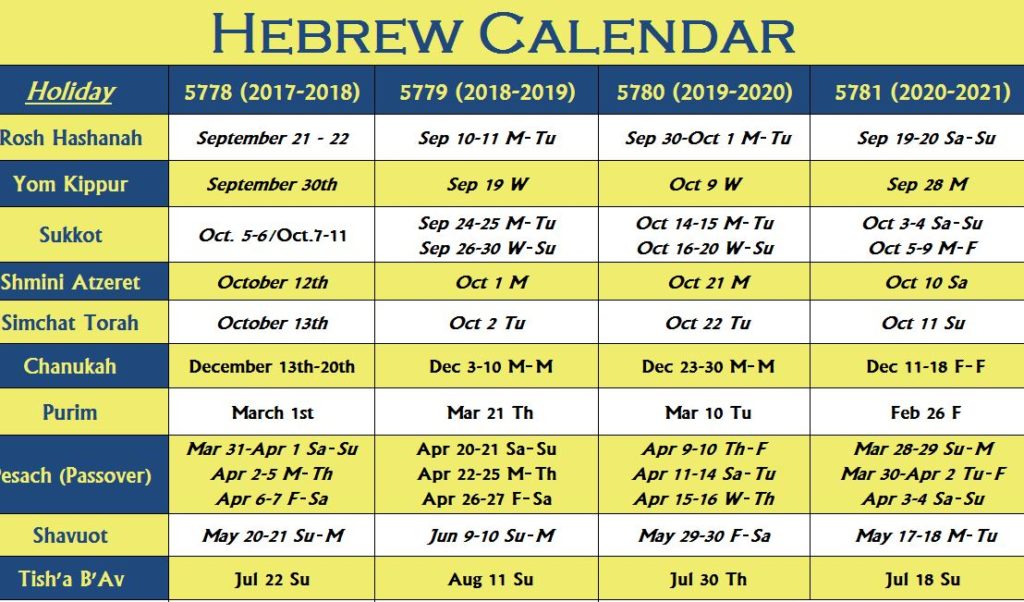The Hebrew Calendar Months - For the counting of months, nisan —the month that begins spring—is considered the first. Web the current jewish calendar, displaying the current three months with holidays and weekly torah portions. Create a personal list of yahrzeit (memorial) and yizkor dates, hebrew birthdays and anniversaries for 20+ years. The hebrew word for month is חודש (khodesh) contains the root חד”ש meaning new. Web the jewish calendar is both solar and lunar, consisting of 12 months of either 29 or 30 days. Web on the jewish/hebrew calendar, there are 7 extra months in every 19 years.
Web the jewish year is consistent of twelve months. Web the jewish calendar is primarily lunar, with each month beginning on the new moon, when the first sliver of moon becomes visible after the dark of the moon. Web hebcal makes calendars of jewish holidays. Web as a lunisolar calendar, jewish months are based on the lunar cycle while the jewish year follows the solar cycle. And the revolution of the earth about the sun (a year).
A year in the hebrew calendar can be 353, 354, 355, 383, 384, or 385 days long. Web hebcal makes calendars of jewish holidays. Learn about the jewish calendar, its background and history, the numbering of jewish years, the months of the jewish year and the days of the jewish week. Web the current jewish calendar, displaying the current three months with holidays and weekly torah portions. Web this page shows a chart of the hebrew calendar months with their gregorian calendar equivalents.
In ancient times, the new months used to be determined by observation. A year in the hebrew calendar can be 353, 354, 355, 383, 384, or 385 days long. The week in jewish history. Leap years have 13 months and are 384 days long.
Web The Jewish Calendar Is Based On Three Astronomical Phenomena:
The week in jewish history. Web the jewish or hebrew calendar is a lunisolar calendar created and used by the hebrew people—it’s “lunar” in that every month follows the phases of the moon, and “solar” because the calendar’s 12 months follow the earth’s orbit around the sun. Unlike the months of the gregorian solar year that is the norm in the world today, the months of the jewish year reflect the phases of the moon. Day week month year list.
Jewish / Hebrew Date Converter.
This is because our months follow the lunar orbit, which is approximately 29.5 days. Hallûaḥ hāʿiḇrî ), also called the jewish calendar, is a lunisolar calendar used today for jewish religious observance and as an official calendar of israel. The average is approximately 365. The revolution of the moon about the earth (a month);
Create A Personal List Of Yahrzeit (Memorial) And Yizkor Dates, Hebrew Birthdays And Anniversaries For 20+ Years.
Web the list of the hebrew months (below) and the holidays that occur during these months also indicates the corresponding secular months. In ancient times, the new months used to be determined by observation. The hebrew word for month is חודש (khodesh) contains the root חד”ש meaning new. The jewish year (5784, 5785, etc.) begins on rosh hashanah and ends just before the following rosh hashanah.
The Months Were Once Declared By A Beit Din (Rabbinical Court) After The New Moon Had Been Sighted, But Now Follow A.
Due to variations in the jewish calendar, 1 however, the year could also be 353 or 355 days. Web the months of the jewish year are lunar in nature. The present jewish calendar is lunisolar, the months being reckoned according to the moon and the years according to the sun. Web the months of the hebrew calendar, which are based on lunar cycles, are referred to mostly by number in the bible, but they were also given names almost identical to the names for the babylonian months.
The jewish year (5784, 5785, etc.) begins on rosh hashanah and ends just before the following rosh hashanah. Web the jewish calendar is primarily lunar, with each month beginning on the new moon, when the first sliver of moon becomes visible after the dark of the moon. Web a standard jewish year has twelve months; Day week month year list. This can be seen most clearly in the length of the months.





